The Milwaukee Streetcar Project: City of Milwaukee Issues Request For Proposals for Construction Manager/General Contractor
Proposals due June 1, with selection slated for late June
Milwaukee (April 18, 2016) – The City of Milwaukee Department of Public Works (DPW) issued a Request for Proposals (RFP) today to procure a Construction Manager/General Contractor (CM/GC) to provide preconstruction and construction services for The Milwaukee Streetcar Project Phase 1 and the Lakefront Line extension.
The CM/GC will be responsible for all construction activities, including installation of the rail, systems including the overhead contact system and streetcar stops – all necessary civil and road work – and the operations and maintenance facility.
This RFP and supporting documentation is available on the City of Milwaukee’s Department of Public Works website at milwaukee.gov/mpw. Potential proposers should call (414) 286-3314 to have their company’s name and contact information placed on the plan holder’s list once they have printed the RFP.
Proposals are due at the Department of Public Works by 4 p.m. June 1, 2016 and should be addressed to the City Engineer. The City hopes to select and engage a CM/GC later in June.
It is anticipated that construction for Phase 1 and the operations and maintenance facility will start late Summer/early Fall 2016 and will extend through 2017 into 2018. The first Brookville streetcar vehicle is anticipated to be delivered in December 2017. After construction is complete there will be a lengthy testing and start-up period. Revenue service for Phase 1 is planned for Fall 2018. Anticipated revenue service for the Lakefront Line is sometime in 2019.
Currently Phase 1 and the operations and maintenance facility are at a 95% design level, and the Lakefront Line is at 30%. The Lakefront Line project recently approval to proceed with the award of the federal TIGER funding last October. Utility relocations have started in advance of the mainline construction activities last fall and are currently underway. Utility work will continue through 2016 into 2017.
The CM/GC procurement method allows for the City to select a contractor based on price, qualifications and approach to the project. The CM/GC approach is the most common project delivery method for streetcar construction projects in the U.S., and has been used in Kansas City, Detroit, Portland, Seattle, Salt Lake City and Tacoma.
Background on The Milwaukee Streetcar is available at themilwaukeestreetcar.com.
Renderings
NOTE: This press release was submitted to Urban Milwaukee and was not written by an Urban Milwaukee writer. While it is believed to be reliable, Urban Milwaukee does not guarantee its accuracy or completeness.

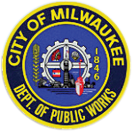
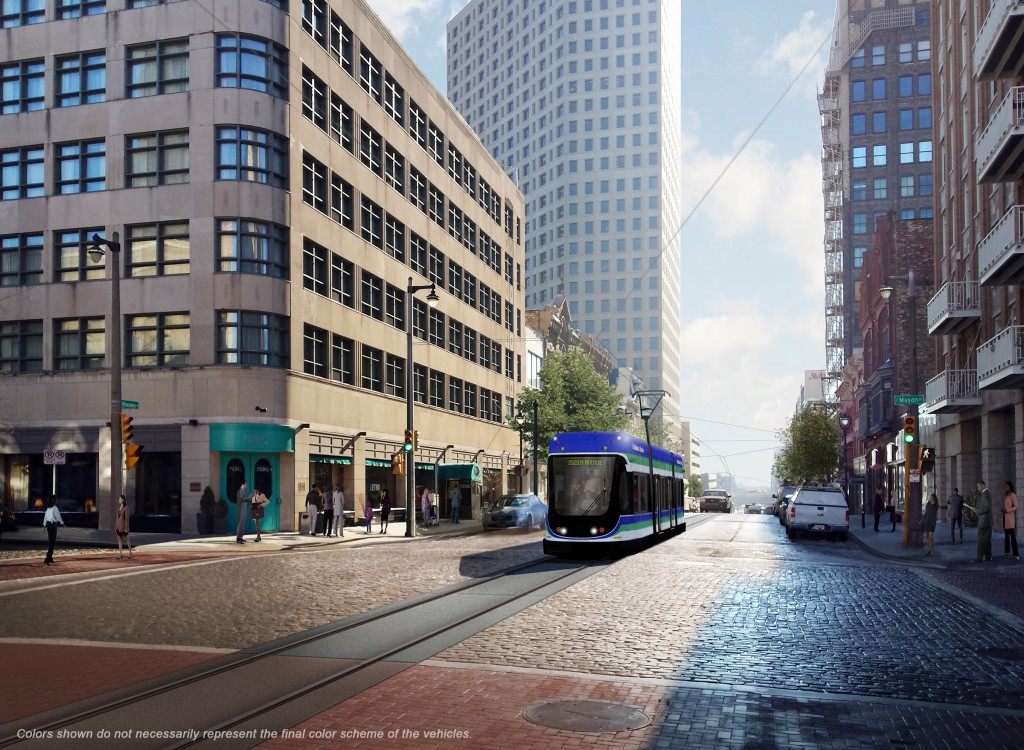
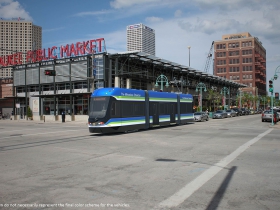
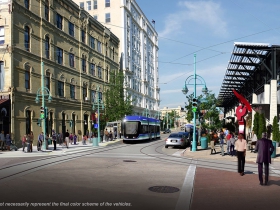
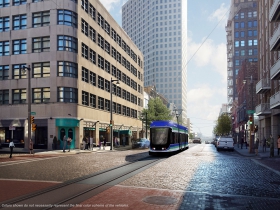
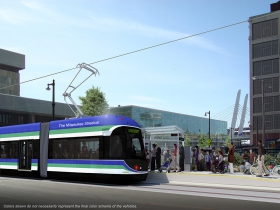
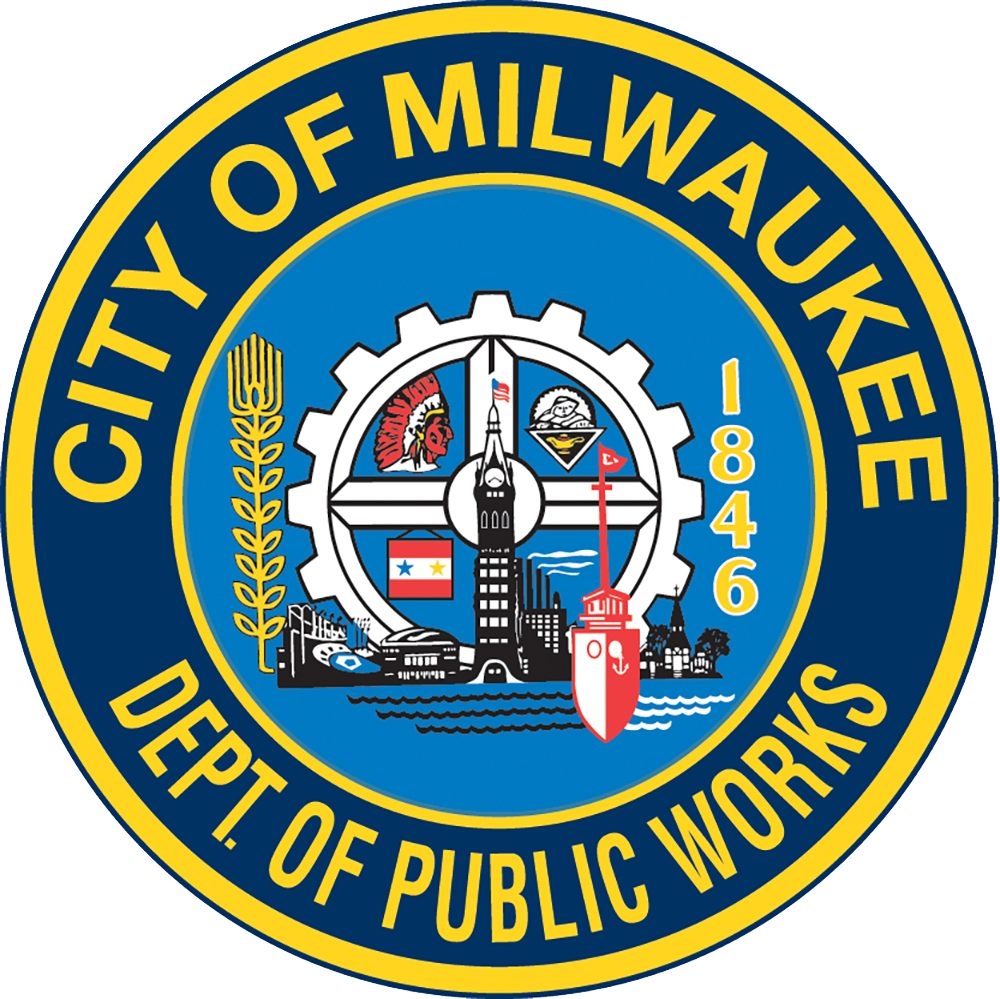




















Up to $25,000,000 in utility relocation costs all to run a streetcar around in a circle, something a dedicated bus lane could have just as easily done. Meanwhile thousands of Milwaukee residents still have lead laterals contaminating the drinking water that goes into their homes and the city has no plan to deal with that. Barrett is a failure as a leader and cares more about creating a faux-legacy than the health and safety of this city’s residents.
I don’t understand this idea that a city like Milwaukee can or should only focus on a set number of issues at any given time. I also love it how suddenly every streetcar critic is a massive bus fan. That was never the case before the streetcar. They never made a peep about transit cuts and other transit problems here, but now they just love the bus. Not to mention bus or nothing is just extremely obtuse thinking. But yes Joe I’m sure your heart just bleeds for city residents with contaminated drinking water. What are you doing about it other than exploiting it to make an anti-streetcar point?
I ride the bus daily. You apparently can’t refute the point that a dedicated bus lane could do everything the streetcar does at a fraction of the cost, so you’ve decided to get personal. Typical. Got any response to the actual point?
I’m also not saying the city can only focus on a set number of issues, but the reality is that government has limited resources, and quality governing is therefore almost entirely a matter of prioritization. If we are going to spend $25,000,000 on utilities I think that money would be better spent on replacing lead laterals that feed many residents our drinking water than on paving the way for a streetcar. Perhaps you disagree but I have to wonder why you appear this angry that someone would hold my opinion.
If Barrett has prioritized both, and I simply missed his plan to replace the city’s remaining lead laterals, feel free to point it out.
Of course the point can be refuted Joe. Here’s some reading material for you: http://www.urbanreviewstl.com/2013/07/why-not-bus-rapid-transit-brt-instead-of-modern-streetcar/ AND http://beyonddc.com/?p=1733 AND http://www.thetransportpolitic.com/2011/05/25/the-silly-argument-over-brt-and-rail/
Again, where were all the bus proponents prior to the streetcar announcement? Where were all the calls for increased transit funding and BRT? Where were the rallies opposing cuts to bus routes?
Of course I am concerned about contaminated drinking water Joe, but it’s hardly an either/or proposition.
Also, you mention $25 million for the utilities for the streetcar. The cost to address contaminated drinking water? More than $500 million. http://www.jsonline.com/news/milwaukee/milwaukee-facing-daunting-costs-with-lead-water-pipes-b99658687z1-366754751.html
As for what Barrett is doing, “Milwaukee Mayor Tom Barrett said, while public works and health officials plan how they will work with property owners to remove the lead service laterals throughout the city.”
So it looks like you’re flat-out wrong about Barrett not doing or saying anything about this.
So why not get started? If the cost to replace lead laterals is that high, doesn’t that make it even more stupid to spend $25MM on relocating utilities for a streetcar when you could have made a dedicated bus lane without moving utilities instead?
I guess you’re right though, Barrett did say something. I suppose the bar is so low that this constitutes leadership.
They are separate issues. It is not either/or. And how easy is it to replace lead laterals in a pretty large city? Just snap your fingers and it’s done?
Of course nothing is good enough for Barrett critics. I’m sure Bob Donovan would have solved the problem no later than yesterday.
The Urban Review article you posted makes an even better case for BRT than I did. Thanks for sharing that.
Just because you happened not to hear enough clamoring from bus supporters during the debate over the streetcar doesn’t mean they weren’t speaking, nor does it have any reflection on whether their viewpoints are valid. I don’t even understand the logic behind the “where were those people before” argument – just sounds like another way to make things personal rather than discuss issues on the merits.
“It is not either/or.” Except in cases involving selective allocation of government funding and priority, it literally is “either/or.”
“Just snap your fingers and its done?” Nobody said it was easy. Is that the threshold for whether government projects are worth undertaking? The streetcar wasn’t a finger snap either. Of course it will be difficult to replace lead laterals. That didn’t stop Madison from doing it anyways.
But you’re probably right – we should only save the easy projects for an ineffectual mayor like Barrett. I’ll wait for a real mayor like the ones we used to have to tackle the real problems of Milwaukee.
It’s a valid argument because people are not being sincere. They don’t really care about public transportation or the city having a viable bus system. That is why they never spoke out or did anything when transit cuts were made here. They suddenly care about the bus just so they can be anti-streetcar.
You are welcome. If you actually read them, the articles make the case that each have advantages and disadvantages. BRT is not better than streetcars.
I’ve spoken at the time and so have many others. Are you really going to pretend that nobody has protested transit cuts in Milwaukee? The fact that you happened not to hear my position before has no bearing on whether the position is valid. Again you want to make this about the people speaking rather than what they are actually saying. That’s a sign of a losing argument.
” Nobody said it was easy. Is that the threshold for whether government projects are worth undertaking?”
Right and as that article points out action is being taken. But that doesn’t satisfy Barrett haters.
What action? Putting reconstruction of water mains on hold until they figure out what to do constitutes action? Again, I think the bar is so low in this city that you might actually believe that, which is sad.
Not that nobody has protested transit cuts. That the anti-streetcar folks didn’t. Big difference. I’ve lived here long enough to know that those folks didn’t care about the bus system or viable public transportation until the streetcar was announced. Suddenly no one loved the bus more. It is totally and completely disingenuous.
OK bud. You know who every anti-streetcar person is, whether they ride the bus, whether they’ve protested transit cuts, etc.
You’re delusional. You have an idea of an opponent in your head and that’s the only person you’ll argue against, regardless of reality. Enjoy beating down your strawman.
You just admitted that it’s not easy Joe, so let’s see what they propose. It’s too early to declare a failure here.
Easy Joe. Simmer down. Are you claiming that anti-streetcar folks were out there in large numbers protesting transit cuts and demanding viable public transportation prior to the streetcar’s announcement?
Should be amusing to watch this debacle unfold in slow motion for the next 10 years. Tens of millions of dollars worth of amusement? Probably not, but hey, at least it’s something.
Hey the fine people in Washington County will be amused! That’s all that matters.
The EPA’s Lead and Copper Rule has existed since the early 90’s. Barrett has been mayor for over a decade. The only thing he’s done about lead laterals during his time in office was halt reconstruction of water mains after disrupting pipes raised the lead levels in peoples’ water. Once again, that’s leadership to you, but not to me.
“Are you claiming that anti-streetcar folks were out there in large numbers protesting transit cuts” Interesting that you keep moving the goalposts. Who cares whether someone taking a position meets whatever your subjective definition of “large numbers” happens to be? Were you at every meeting? Have you reviewed every public commentary on the issue? Why is the sincerity of your opponent the only thing you care about? Do I sound insincere to you? Because right now I’m the only one you’re talking to. Try to remember that and stay on topic if you’re capable.
I am not moving the goalposts Joe. You are dodging and yes you do seem insincere to me. Hostile and defensive too.
Let’s try again. I have lived here since ’97. In my opinion, generally speaking, the people who are now adamantly pro-bus and anti-streetcar did not protest transit cuts and advocate for BRT or viable public transportation here before the announcement of the streetcar. They didn’t formally organize and hold rallies and demonstrate against the transit cuts. Is that incorrect? Is your experience different?
Whether the generality you described is accurate or not, it has no bearing on my point regarding BRT doing much of what a streetcar can do at a fraction of the cost. Something you either have no desire or capability to discuss.
I get it. Anti-streetcar people tend to be anti-transit regardless of the issue. I happen not to be one of those people. Let me know when you’re ready to move past the “sincerity” issue and actually discuss my original post.
What are you talking about Joe? You are flat-out lying now. I posted a link to three articles making the case that BRT is not better than a streetcar. We can discuss that more. I never said I wouldn’t discuss that. Please don’t just make things up.
I am glad you aren’t anti-transit regardless. That’s good.
I didn’t know barfing out links constituted discussion. I’ll respond to the Beyond DC claims in support of streetcars over BRT.
Streetcars have greater capacity than buses
Is there any reason to believe there is sufficient demand for public transit from the St. Paul to Ogden that would fill more than an accordion bus? I have to admit I’ve rarely, if ever, seen even a single bus on any route in Milwaukee that was filled to standing room. Even if there were sufficient demand, two or three double-buses could be run in succession rendering this point a nullity.
Streetcars can be more affordable than buses over the long term
Except in this case they aren’t and won’t be.
Streetcar tracks reassure riders they’re on the right route.
Something that can just as easily be accomplished by speaking to your driver.
Streetcars stand out.
Something that can just as easily be accomplished by better bus design.
Streetcars are more comfortable to ride than buses.
Something that can just as easily be accomplished by better bus design.
Streetcars are economic development magnets.
No they arent. Nobody knows that for sure, they only know BRT is.
http://www.citylab.com/work/2013/09/when-it-comes-streetcars-and-economic-development-theres-still-so-much-we-dont-know/6899/
Streetcars are quieter and cleaner than buses.
Streetcars require audible pedestrian/vehicle warning bells which are arguably louder than any bus. I’ll concede the point of “clean” though I couldn’t find any readily available sources on how much “cleaner” a streetcar running on electricity is than a hybrid/clean-emissions bus.
Streetcars are sometimes faster than buses.
Sometimes. But consider a BRT bus with a dedicated lane and the same number of stops as a streetcar. How would the streetcar be faster? It’s still subject to traffic control which can be manipulated with a bus lane just as easily.
Streetcars attract more riders than buses.
I could not find any study on that issue that wasn’t 20+ years old. Regardless, if the route and transit time is the same, I don’t see why someone would ride a streetcar but not ride a bus. Care to fill me in?
At the end of the day, the money would be better spent either upgrading current transit and focusing on BRT, or shooting for rail either above or below the street. I realize that’s been opposed heavily by anti-transit types but I think a better leader could have gotten it done. To me a streetcar is a situation where everyone loses.
Joe, a BRT is not a good substitute for a streetcar. BRT systems are designed to move people longer distances and take less time than a regular bus line. Streetcars on the other hand do a very good job of moving people within a dense area and provide for a fixed route which attracts capital investment and increased property values because you know it won’t be moved to another street.
BRT and the streetcar compliment each other because the BRT can get you downtown and then the streetcar can move you around once you’re there.
AG:
BRT systems are designed to move people longer distances and take less time than a regular bus line
What’s stopping the City of Milwaukee from creating a dedicated bus lane where they’re putting the streetcar? Just because BRT is typically used to bring people in from the suburbs doesn’t mean its principles of speed and efficiency can’t be used to supplant a streetcar.
attracts capital investment
The only known attraction of capital investment comes from BRT. Nobody knows if a streetcar does the same, so why do so many people spout that?
http://www.citylab.com/work/2013/09/when-it-comes-streetcars-and-economic-development-theres-still-so-much-we-dont-know/6899/
BRT and the streetcar compliment each other because the BRT can get you downtown and then the streetcar can move you around once you’re there.
Why not go from a bus to a bus? I don’t see how going from a bus to a streetcar is any different or better.
So Joe you believe Milwaukee should have a bus-only transit system? Would you oppose any bus-alternative system?
Joe says: “The only known attraction of capital investment comes from BRT. Nobody knows if a streetcar does the same, so why do so many people spout that?”
Because it does. Proof is clearly available right here in Milwaukee. The streetcar line hasn’t even started in earnest yet, but we already have quite a few projects and developers who said the streetcar line has influenced their decision making process. How many times have we heard “near the future streetcar line” as a benefit to a project? I don’t recall ever hearing that about bus routes…
I actually just said above that I support buses, BRT, as well as rail that goes above and below ground. Streetcars, to me, tend to be the worst of all worlds – they can’t move around obstructions like a bus can, yet they are just as dependent on traffic as a bus.
As to the proposed developments you pointed out along our future streetcar line, it’s been noted by some that streetcars tend to concentrate development that would have happened anyways along a particular corridor. That wouldn’t necessarily be a bad thing if the streetcar was being built in an area that was in dire need of economic development (of which there are many in our city), but it isn’t. As for me, economic development is the last thing I care about when discussing transit. My primary concern is – does it quickly get people where they need to go?
Here’s an article that basically sums up my thoughts on streetcars generally, and I think the scenarios in which streetcars are envisioned as beneficial simply are not present in Milwaukee.
http://humantransit.org/2009/07/streetcars-an-inconvenient-truth.html
I think once the system is expanded (as is the plan) it could complement the bus system and give Milwaukee the viable public transportation system it needs. I wish the high-speed rail plan had happened but we all know that’s dead and gone.
A strong downtown is important so I wouldn’t be so dismissive of economic development there, but yes it needs to be improved in other parts of the city as well.
Joe (post 24):
Streetcars do attract more riders than buses. PolitiFact verified this after studying it.
When Portland opened its streetcar in 2001, bus ridership in that area (within 1/6 mile of the streetcar) declined by 20%, but the streetcar ridership was much greater than the lost bus ridership. Not only did people switch from buses to streetcars, but many people who hadn’t used transit started riding streetcars (but not the buses).
http://www.politifact.com/oregon/statements/2012/apr/03/charlie-hales/do-streetcars-really-beat-out-buses-capacity-rider/
Streetcars are quieter than buses. The whole reason streetcars need a bell in the first place is because they are so quiet. And unlike a diesel engine (which is continuously loud), the bell only sounds when the driver needs to get a pedestrian’s attention. The bell is not used to warn drivers (it’s not loud enough); the streetcar has a standard vehicular horn for that purpose.
Streetcars are development magnets. Read this:
http://www.portlandstreetcar.org/pdf/development_200804_report.pdf
As to your suggestion that you would support a Milwaukee subway… Do you know how much that would cost? New York City is paying about $3 billion/mile for subway tunnels and stations (and this doesn’t include the cost of subway cars, storage yards, maintenance facilities, etc).